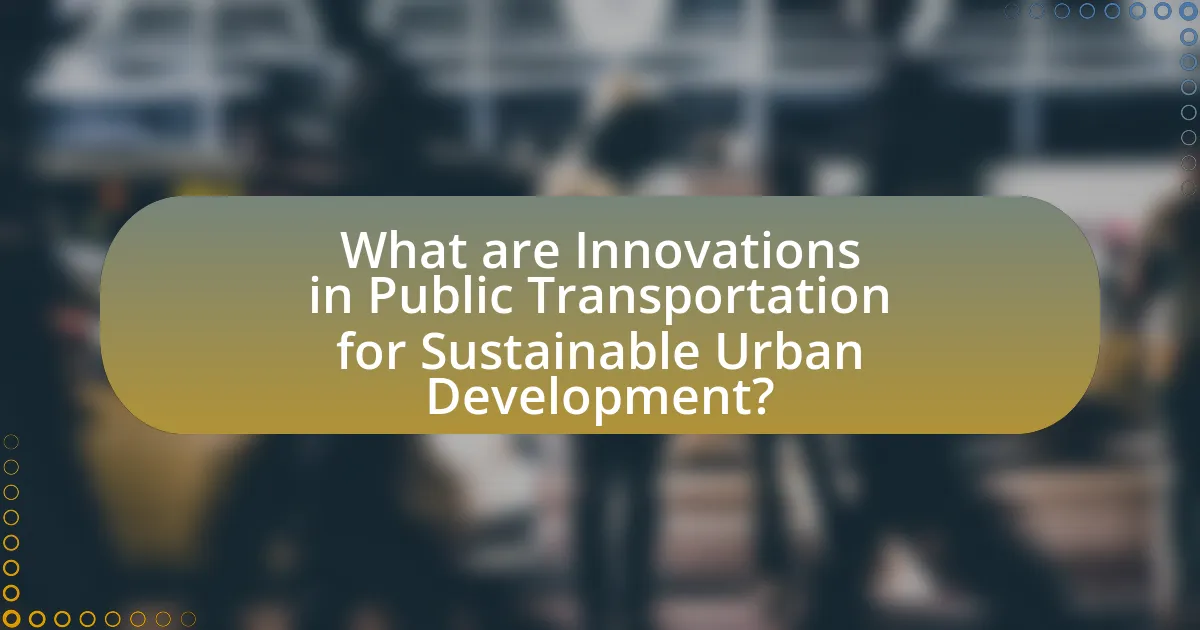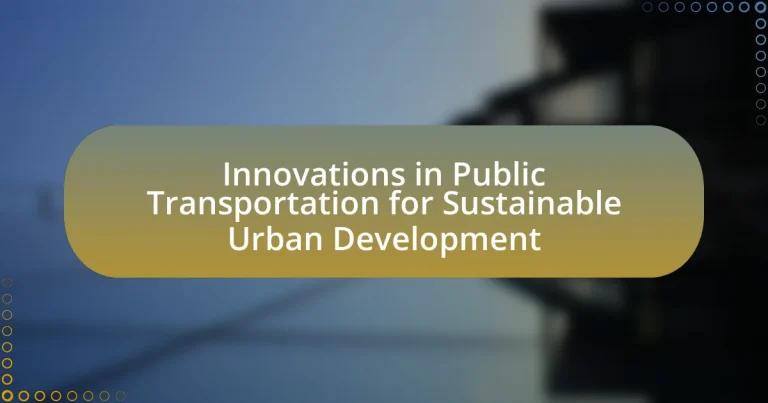Innovations in public transportation are crucial for sustainable urban development, encompassing technologies such as electric buses, autonomous vehicles, and integrated mobility platforms. These advancements aim to reduce greenhouse gas emissions, enhance air quality, and improve accessibility in urban areas. Key trends include the adoption of real-time tracking systems, smart ticketing solutions, and multimodal transportation options, which collectively contribute to increased efficiency and reduced reliance on personal vehicles. Challenges such as funding constraints and public acceptance are significant hurdles that cities must navigate to successfully implement these innovations, while best practices emphasize the importance of community engagement and collaboration among stakeholders.

What are Innovations in Public Transportation for Sustainable Urban Development?
Innovations in public transportation for sustainable urban development include electric buses, autonomous vehicles, and integrated mobility platforms. Electric buses reduce greenhouse gas emissions and improve air quality, with cities like Los Angeles transitioning to a fleet of over 1,000 electric buses by 2028. Autonomous vehicles enhance efficiency and safety, as demonstrated by pilot programs in cities such as San Francisco. Integrated mobility platforms, like those developed by companies such as MaaS Global, combine various transportation modes into a single accessible service, promoting seamless travel and reducing reliance on personal vehicles. These innovations collectively contribute to more sustainable urban environments by decreasing congestion, lowering emissions, and improving public transit accessibility.
How do these innovations contribute to sustainability?
Innovations in public transportation contribute to sustainability by reducing greenhouse gas emissions and promoting energy efficiency. For instance, electric buses and trains produce zero tailpipe emissions, significantly lowering urban air pollution levels. According to the American Public Transportation Association, public transit use can reduce individual carbon footprints by up to 45% compared to driving alone. Additionally, advancements such as real-time tracking and smart ticketing systems enhance operational efficiency, leading to increased ridership and reduced congestion, which further supports sustainable urban development.
What specific technologies are being implemented in public transportation?
Public transportation is increasingly implementing technologies such as real-time tracking systems, contactless payment solutions, electric and hybrid vehicles, and smart traffic management systems. Real-time tracking systems utilize GPS and mobile applications to provide passengers with live updates on vehicle locations and arrival times, enhancing user experience and efficiency. Contactless payment solutions, including mobile wallets and smart cards, streamline fare collection and reduce boarding times. Electric and hybrid vehicles contribute to reducing emissions and promoting sustainability in urban environments. Smart traffic management systems leverage data analytics and IoT to optimize traffic flow and reduce congestion, improving overall service reliability. These technologies collectively support the goal of sustainable urban development by enhancing the efficiency and environmental performance of public transportation systems.
How do these technologies reduce carbon emissions?
Innovations in public transportation technologies reduce carbon emissions by enhancing energy efficiency and promoting the use of cleaner energy sources. For instance, electric buses and trains emit zero tailpipe emissions, significantly lowering greenhouse gas output compared to traditional diesel vehicles. According to the American Public Transportation Association, public transit use can reduce individual carbon footprints by up to 45% per mile. Additionally, smart transit systems optimize routes and reduce idle times, further decreasing fuel consumption and emissions. These advancements collectively contribute to a more sustainable urban environment by minimizing reliance on fossil fuels and improving air quality.
What role does public transportation play in urban development?
Public transportation is essential for urban development as it enhances accessibility, reduces traffic congestion, and promotes sustainable growth. By providing efficient transit options, cities can connect residents to jobs, education, and services, thereby fostering economic development. For instance, studies show that areas with robust public transit systems experience higher property values and increased business activity. Additionally, public transportation contributes to environmental sustainability by lowering greenhouse gas emissions; the American Public Transportation Association reports that public transit saves 45 million metric tons of carbon dioxide annually. Thus, public transportation is a critical component in shaping urban environments that are economically vibrant and environmentally responsible.
How does efficient public transportation influence urban planning?
Efficient public transportation significantly influences urban planning by promoting higher density development and reducing reliance on personal vehicles. This shift encourages planners to design cities that prioritize accessibility, leading to mixed-use developments that integrate residential, commercial, and recreational spaces. For instance, cities like Portland have implemented transit-oriented development, resulting in a 20% increase in public transit ridership and a corresponding decrease in traffic congestion. Such planning not only enhances mobility but also supports sustainable practices by minimizing carbon emissions and preserving green spaces.
What are the social benefits of improved public transportation systems?
Improved public transportation systems provide significant social benefits, including increased accessibility, reduced traffic congestion, and enhanced community cohesion. These systems enable individuals, particularly those without private vehicles, to access jobs, education, and essential services, thereby promoting economic opportunities and social equity. For instance, a study by the American Public Transportation Association found that public transit reduces congestion costs by $4.6 billion annually, which translates to less time spent in traffic and improved air quality. Furthermore, enhanced public transportation fosters social interactions among diverse community members, contributing to a sense of belonging and community engagement.

What are the key trends in public transportation innovations?
Key trends in public transportation innovations include the integration of electric and autonomous vehicles, the use of real-time data analytics for improved service efficiency, and the development of multimodal transportation systems. Electric vehicles are being adopted to reduce emissions, with cities like Los Angeles aiming for a fully electric bus fleet by 2030. Autonomous vehicles are being tested in various urban environments, enhancing safety and reducing operational costs. Real-time data analytics, utilized by platforms like Transit and Citymapper, optimize routes and improve user experience by providing timely information. Multimodal systems, which combine various forms of transport, are being implemented in cities such as Amsterdam, promoting seamless transitions between biking, public transit, and walking. These trends collectively contribute to sustainable urban development by enhancing accessibility, reducing environmental impact, and improving overall efficiency in public transportation systems.
How is electrification transforming public transportation?
Electrification is transforming public transportation by significantly reducing greenhouse gas emissions and improving energy efficiency. Electric buses and trains produce zero tailpipe emissions, which contributes to cleaner urban air quality and aligns with global sustainability goals. For instance, a study by the International Council on Clean Transportation found that electric buses can reduce emissions by up to 70% compared to diesel buses. Additionally, electrification enhances operational efficiency through lower fuel and maintenance costs, making public transport systems more economically viable. As cities adopt electric fleets, they are also investing in charging infrastructure, which further supports the transition to sustainable urban mobility.
What are the advantages of electric buses and trains?
Electric buses and trains offer significant advantages, primarily in reducing greenhouse gas emissions and improving air quality. These vehicles produce zero tailpipe emissions, which contributes to lower levels of pollutants in urban environments. According to the U.S. Department of Energy, electric buses can reduce emissions by up to 70% compared to diesel buses, significantly mitigating the impact of public transportation on climate change. Additionally, electric buses and trains are generally quieter than their diesel counterparts, leading to reduced noise pollution in cities. The operational costs of electric vehicles are also lower due to reduced fuel and maintenance expenses, making them economically advantageous for public transit systems.
How does electrification impact operational costs?
Electrification significantly reduces operational costs in public transportation by lowering fuel expenses and maintenance requirements. Electric vehicles typically have lower energy costs compared to diesel or gasoline, with electricity prices often being more stable and predictable. Additionally, electric vehicles require less maintenance due to fewer moving parts and no need for oil changes, which further decreases long-term operational costs. For instance, a study by the International Council on Clean Transportation found that electric buses can save up to 70% on fuel costs and 30% on maintenance costs compared to their diesel counterparts.
What is the significance of smart technology in public transportation?
Smart technology significantly enhances public transportation by improving efficiency, safety, and user experience. It enables real-time tracking of vehicles, optimizing routes and schedules based on demand, which leads to reduced wait times and increased ridership. For instance, cities implementing smart traffic management systems have reported up to a 30% decrease in congestion and a corresponding increase in public transport usage. Additionally, smart technology facilitates better communication between transit authorities and passengers, providing timely updates and improving overall satisfaction. This integration of technology not only streamlines operations but also supports sustainable urban development by promoting the use of public transport over personal vehicles, thereby reducing carbon emissions.
How do smart apps enhance user experience in public transport?
Smart apps enhance user experience in public transport by providing real-time information, personalized services, and seamless connectivity. These applications allow users to access live updates on schedules, delays, and routes, which significantly reduces wait times and uncertainty. For instance, a study by the International Transport Forum found that real-time tracking can improve user satisfaction by up to 30%. Additionally, smart apps often include features like mobile ticketing, which streamlines the payment process, and route optimization, which helps users find the quickest paths to their destinations. This integration of technology not only makes public transport more efficient but also encourages higher usage rates, contributing to sustainable urban development.
What role does data analytics play in optimizing routes?
Data analytics plays a crucial role in optimizing routes by enabling transportation systems to analyze vast amounts of data to identify the most efficient paths for vehicles. By utilizing real-time data, such as traffic patterns, weather conditions, and passenger demand, transportation agencies can make informed decisions that reduce travel time and operational costs. For instance, a study by the Transportation Research Board found that data-driven route optimization can lead to a 10-20% reduction in fuel consumption and emissions, contributing to more sustainable urban development. This analytical approach not only enhances service reliability but also improves overall user satisfaction in public transportation systems.

What challenges do cities face in implementing these innovations?
Cities face significant challenges in implementing innovations in public transportation for sustainable urban development, primarily due to funding constraints. Many municipalities struggle to secure the necessary financial resources to invest in new technologies and infrastructure, as evidenced by a report from the American Public Transportation Association, which indicates that public transit systems in the U.S. face a funding shortfall of approximately $90 billion over the next decade. Additionally, regulatory hurdles can impede the adoption of innovative solutions, as existing laws may not accommodate new technologies such as autonomous vehicles or electric buses. Furthermore, public resistance to change can hinder the implementation process, with studies showing that community buy-in is crucial for the success of new transportation initiatives. These factors collectively create a complex environment that cities must navigate to successfully implement innovative public transportation solutions.
How do funding and investment affect public transportation innovations?
Funding and investment significantly drive public transportation innovations by providing the necessary financial resources for research, development, and implementation of new technologies. For instance, cities that allocate substantial budgets towards public transit often see advancements in electric buses, smart ticketing systems, and real-time tracking technologies. According to the American Public Transportation Association, every $1 invested in public transportation generates approximately $4 in economic returns, highlighting the impact of financial support on innovation. Furthermore, government grants and private investments facilitate partnerships between public agencies and technology firms, leading to the development of sustainable solutions that enhance efficiency and reduce environmental impact.
What are the common sources of funding for public transportation projects?
Common sources of funding for public transportation projects include federal grants, state and local government funding, public-private partnerships, and dedicated taxes or fees. Federal grants, such as those from the Federal Transit Administration, provide significant financial support, often covering a substantial portion of project costs. State and local governments contribute through budget allocations and bonds, while public-private partnerships leverage private investment to enhance funding. Additionally, dedicated taxes, such as sales taxes or vehicle registration fees, are often earmarked specifically for transportation initiatives, ensuring a steady revenue stream for projects.
How can cities overcome financial barriers to innovation?
Cities can overcome financial barriers to innovation by leveraging public-private partnerships (PPPs) to share costs and risks associated with new projects. These collaborations enable cities to access private sector funding, expertise, and technology, which can significantly reduce the financial burden on public budgets. For instance, the City of Los Angeles partnered with private firms to develop its Metro ExpressLanes, which utilized private investment to enhance public transportation infrastructure while generating revenue through tolls. This model demonstrates how cities can effectively mobilize resources and foster innovation in public transportation, ultimately leading to sustainable urban development.
What are the public perceptions and acceptance of new transportation technologies?
Public perceptions and acceptance of new transportation technologies vary significantly, often influenced by factors such as safety, convenience, environmental impact, and cost. Surveys indicate that a majority of individuals express a willingness to adopt technologies like electric vehicles and autonomous public transport, primarily due to their perceived benefits in reducing emissions and improving urban mobility. For instance, a 2021 study by the International Transport Forum found that 70% of respondents in urban areas support the integration of electric buses, citing environmental concerns as a primary motivator. Additionally, acceptance of autonomous vehicles is growing, with a 2022 Pew Research Center survey revealing that 54% of Americans believe self-driving cars will be common within the next 10 years, reflecting a shift in public sentiment towards innovative transportation solutions.
How can cities engage communities in the planning process?
Cities can engage communities in the planning process by implementing participatory planning methods that include public consultations, workshops, and surveys. These methods allow residents to voice their opinions and contribute to decision-making, ensuring that their needs and preferences are considered. For example, cities like Portland, Oregon, have successfully utilized community engagement strategies, resulting in transportation plans that reflect the desires of local populations. Research indicates that involving communities in planning leads to more effective and accepted outcomes, as seen in studies conducted by the American Planning Association, which highlight the positive correlation between community involvement and project success rates.
What strategies can improve public trust in new systems?
To improve public trust in new systems, transparency and community engagement are essential strategies. Transparency involves openly sharing information about system operations, decision-making processes, and performance metrics, which can be supported by data showing that 70% of citizens are more likely to trust organizations that provide clear information. Community engagement includes involving stakeholders in the planning and implementation phases, as studies indicate that participatory approaches can increase public confidence by up to 50%. Additionally, consistent communication and responsiveness to public feedback can further enhance trust, as evidenced by research from the International Transport Forum, which highlights that systems with active public involvement see higher satisfaction rates.
What best practices can cities adopt for successful implementation?
Cities can adopt integrated planning and stakeholder engagement as best practices for successful implementation of innovations in public transportation. Integrated planning ensures that transportation systems align with urban development goals, facilitating efficient resource allocation and infrastructure development. Stakeholder engagement, involving community members, businesses, and government agencies, fosters collaboration and addresses diverse needs, leading to more effective solutions. For instance, cities like Amsterdam have successfully implemented bike-sharing programs by engaging local communities in the planning process, resulting in increased usage and satisfaction.
How can collaboration between stakeholders enhance project outcomes?
Collaboration between stakeholders enhances project outcomes by fostering diverse perspectives and expertise, leading to more innovative solutions. When stakeholders, such as government agencies, private companies, and community organizations, work together, they can identify and address challenges more effectively. For instance, a study by the National Cooperative Highway Research Program found that collaborative approaches in transportation projects resulted in a 20% increase in project efficiency and a 15% reduction in costs. This synergy not only improves resource allocation but also ensures that the needs of all parties are considered, ultimately leading to more sustainable and successful public transportation initiatives.
What lessons can be learned from successful case studies in urban transportation?
Successful case studies in urban transportation reveal that integrated planning, community engagement, and the adoption of technology are crucial for effective systems. For instance, the implementation of Bus Rapid Transit (BRT) systems in cities like Bogotá, Colombia, demonstrates that dedicated lanes and efficient scheduling can significantly reduce travel times and increase ridership. Additionally, the case of Copenhagen’s cycling infrastructure shows that prioritizing non-motorized transport can lead to a healthier population and reduced emissions. These examples underscore the importance of tailoring solutions to local contexts and involving stakeholders in the planning process to ensure sustainability and public acceptance.


